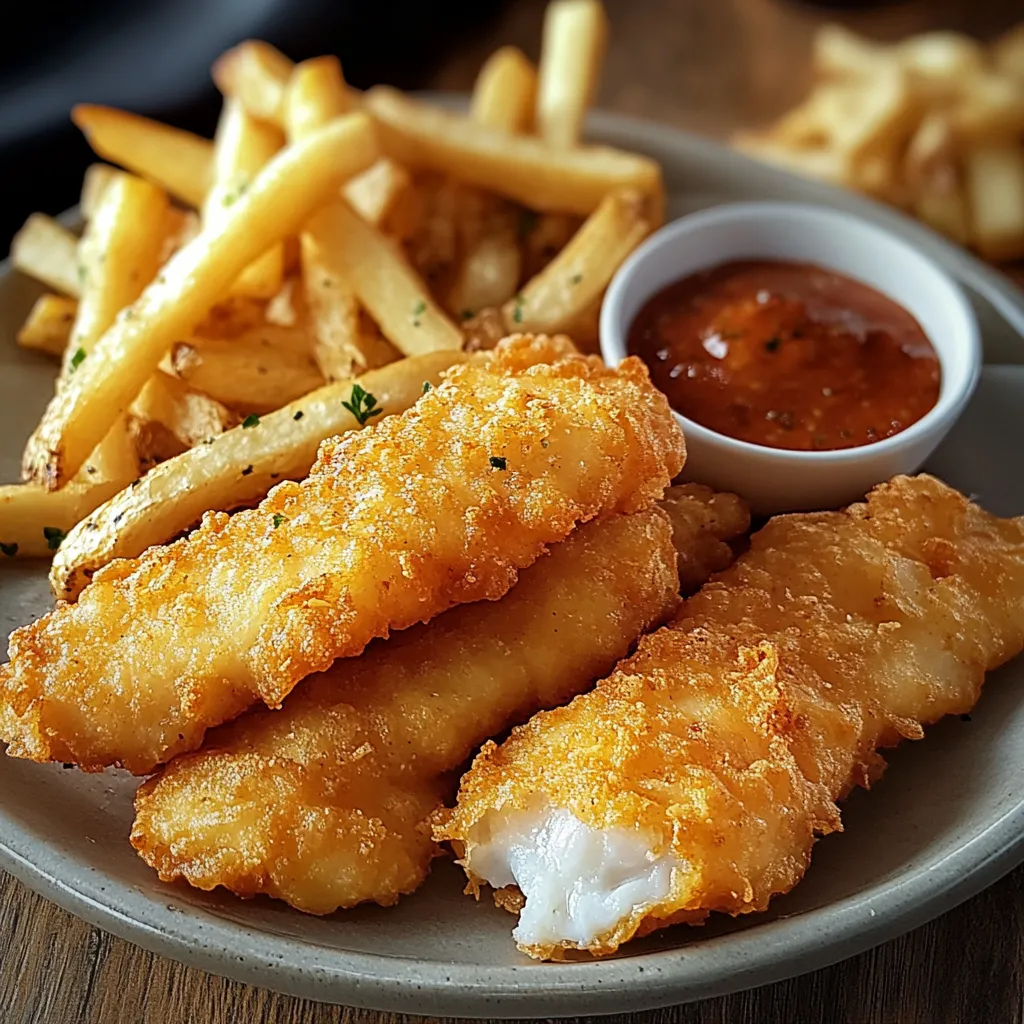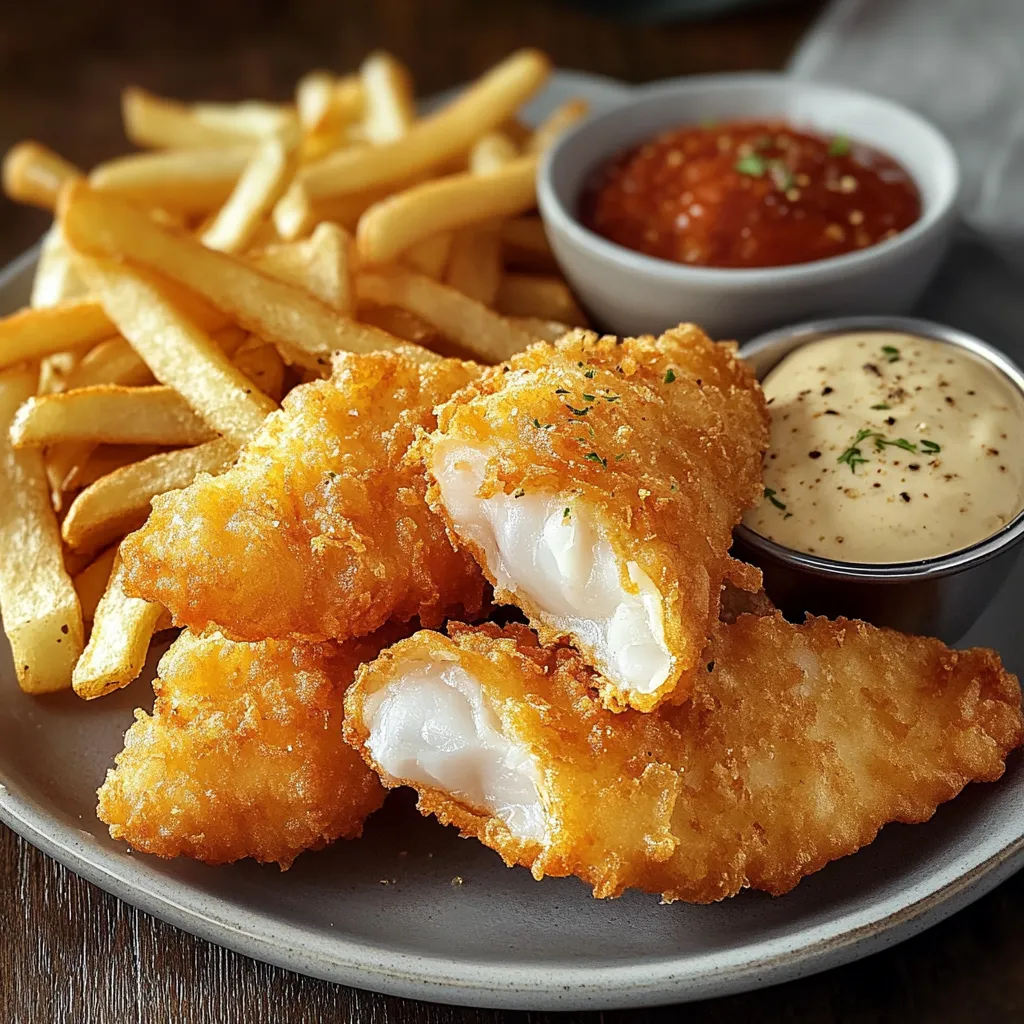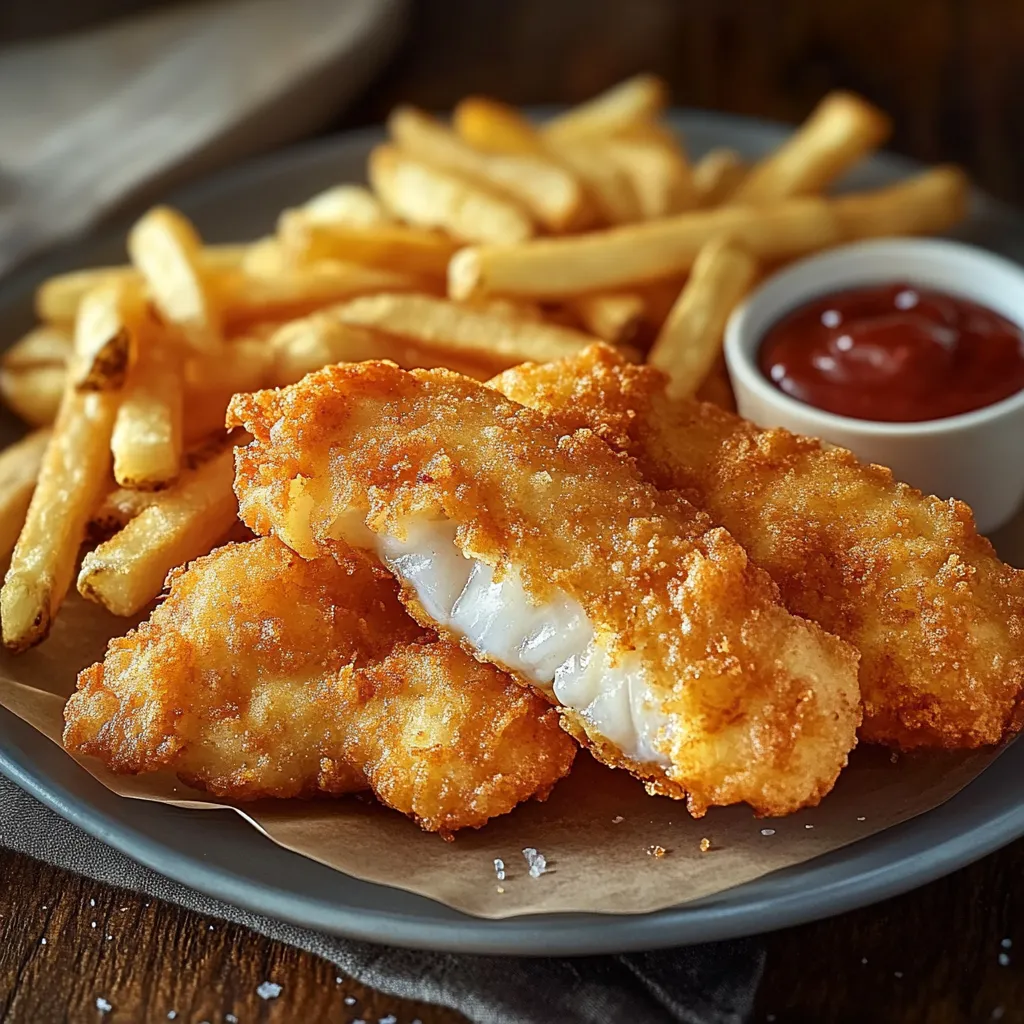 Pin it
Pin it
This no-fuss beer-battered fish and chips brings classic pub flavors straight to your home with golden crisp fish and twice-fried potato chips that stay crunchy outside while staying soft inside.
I tweaked this dish after too many disappointing deliveries that showed up limp and oily. These days my kids race to the dinner table on Fridays, waiting to hear that first delightful crunch.
Ingredients
- White fish fillets (cod or haddock): They're firm and mild-tasting, making them perfect matches for the crunchy coating
- All purpose flour: Forms the base for our airy, crispy outer layer
- Baking powder: Makes the coating puff up nicely when it meets hot oil
- Cold fizzy water: The hidden trick for getting the lightest possible texture
- Russet potatoes: Work best for chips because their starch content gives you fluffy middles
- Vegetable oil: Handles high heat cooking without burning
Step-by-Step Instructions
- Get Your Potatoes Ready:
- Slice potatoes into even thick sticks about ½ inch across. Wash them well under cold water for at least a minute to wash away starch that could make them soggy. Dry them completely with paper towels since any water will cause dangerous oil splashing.
- Cook Chips The First Time:
- Warm your oil to 325°F in a heavy pot. Add potato strips in small batches so the oil stays hot. Cook them for 4 minutes until they're soft but not browned. This first cooking gets the insides done without coloring the outside. Lift them out with a slotted spoon and put on paper towels.
- Mix Up Your Batter:
- In a big bowl, stir together flour, baking powder, paprika, and salt. Make a hole in the middle and pour in very cold fizzy water. Stir gently until just mixed with some small lumps left. Don't overmix or you'll end up with tough coating.
- Batter And Fry The Fish:
- Dry fish pieces with paper towels and sprinkle with salt and pepper. Hold each piece by one end, dip into the batter, let extra drip off for 2 seconds. Carefully lower into 375°F oil facing away from you to avoid splashes. Fry for 4 minutes until golden and crunchy, flipping once halfway.
- Finish The Chips:
- Heat oil to 375°F. Put the partly-cooked potatoes back in the oil in small batches for their second fry. Cook exactly 3 minutes until golden brown and super crunchy. Move to paper towels right away and sprinkle with salt while hot.
- Dish Up Right Away:
- Put fish and chips on plates or in paper-lined baskets. Add a bit of parsley and serve with tartar sauce or traditional malt vinegar. The best bite gives you both the crunch of coating and tender fish inside.
 Pin it
Pin it
Using fizzy water in the batter really changes everything. I learned this trick on a trip to a tiny coastal shop in Cornwall. The owner, who'd been cooking fish and chips for over 40 years, told me the bubbles make tiny air pockets that grow in hot oil, creating that amazing light texture we all want.
The Secret to Non Greasy Results
Getting fish and chips that aren't greasy comes down to oil temp. Always use a thermometer to keep it at 375°F while cooking. When food goes into cooler oil, it soaks up more grease. If it's too hot, the outside burns before the inside cooks. I keep extra oil heating up in case the temperature drops too much between batches.
Traditional Serving Suggestions
In Britain, they wrap fish and chips in newspaper with a splash of malt vinegar and salt. You can copy this by putting parchment paper on serving plates. Serve with mushy peas made from frozen peas cooked with butter and mint for a true British takeaway feel. Some places offer curry sauce or gravy instead of tartar sauce.
Make Ahead Tips
While this dish tastes best fresh, you can prep some parts early. Cut potatoes can stay in cold water in the fridge up to 24 hours. You can do the first fry earlier in the day and keep the potatoes cold until the final cooking just before eating. Always make batter fresh though, since the bubbles from the fizzy water don't last long.
 Pin it
Pin it
There's something truly awesome about making killer fish and chips at home. Savor every bite!
Frequently Asked Questions
- → What type of fish works best for fish and chips?
The top picks are cod and haddock, loved for their sturdy texture and subtle taste. You can also try pollock, halibut, or flounder with good results. Just make sure you pick a white fish that's firm enough to hold up during frying without breaking apart.
- → Why use sparkling water in the batter?
The bubbles in sparkling water puff up when they hit hot oil, making your coating airier and crunchier. The fizz also helps stop the batter from getting tough by limiting gluten development.
- → Why do you fry the chips twice?
The two-step frying trick makes perfect chips - your first dip at lower heat cooks the inside, while the second round at hotter temps creates that crunchy outside. You'll get chips that are soft inside but crispy outside.
- → How can I keep fish and chips crispy until serving?
Don't put them on paper towels! Set them on a wire rack over a baking sheet in a warm oven (around 200°F/95°C). This lets air flow around them so they won't get soggy from trapped steam but will stay nice and warm.
- → What oil is best for frying fish and chips?
Go for mild-tasting oils that can handle high heat. Vegetable, canola, or peanut oil all work great. Real fish and chip shops often use beef fat for that authentic taste, but most home cooks stick with vegetable oil.
- → Can I make the batter ahead of time?
It's best to mix your batter right before cooking. The bubbles from the sparkling water will escape over time, and your batter won't be as light. If you're in a rush, you can mix the dry stuff ahead and just add cold fizzy water when you're ready to cook.
